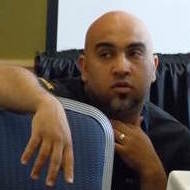
Mena Abdo
August 25, 2014
On this date we featured Meno Abdo, Math, Physics and Engineering Teacher at Buena Park High School in the Fullerton Joint Union High School District.
Mena has found that the best way to reach students is by helping them see the value in what he is trying to teach them, and for him, integrated curriculum makes that value transparent.
“Integrated curriculum is engaging. It’s all about project-based and student-based learning,” said Mena. “You’re telling the students, 'Here’s the product that I need,' and you look at them and tell them to make it happen.” This approach, in which students learn the content and skills of a subject in order to produce something tangible is, according to Mena, absent in “traditional” courses, in which students learn math or physics concepts without understanding “how to use them.”
Mena saw the importance of just such an approach early in his career, when he worked as a math teacher with students who were taking remedial math courses. Mena saw that his students struggled precisely because the math instruction was isolated from meaning—the students couldn't understand the applied function of math, and because of that, they struggled. When he began approaching his tutoring by showing students how math worked in the world, his students began to understand it better and learn in a more effective way. “When students see the application of what they're learning," Mena said, "it’s a huge key to helping them understand the content. It’s all about the whole real-world connection and showing students how to apply what they're learning.”
Mena began his teaching career at Scripps Ranch High School in San Diego, which has its own Sustainable Technologies Program that includes courses focused on green construction, renewable energy and sustainable approaches to engineering and design. Mena was offered the chance to pilot the school’s new sustainable energy program and curriculum, and he jumped at the chance, immediately immersing himself in the process of writing his first course for A-G approval. Introduction to Green Technology and Energy integrates physics with the Energy, Environment, and Utilities CTE Industry Sector, and engages students in hands-on projects including, among other things, experimentation with and construction of electrical circuits such as series circuits, parallel circuits, AC/DC electrical motors, and batteries. The course quickly earned A-G approval in the Laboratory science (D) subject area.
Mena, who is also a master teacher for Project Lead The Way, continually tried to improve Introduction to Green Technology and Energy in ways that increased the hands-on work, especially because the district (San Diego USD) planned to roll the course out at high schools throughout the entire district. During this revision and fine-tuning process, one of his colleagues stumbled across the UCCI course, Green Up and Go: The Physics of "Clean" Engineering, which integrates physics with engineering and design. This discovery led to a UCCI Teacher Exchange event at Scripps Ranch High in the fall of 2013.
At the event, Mena and his colleagues had the chance to work with David Stafford, a physics teacher who was teaching Green Up and Go at Rosemont High School in Sacramento. After the exchange, Mena took some elements from Green Up and Go and weaved them into the Introduction to Green Technology and Energy course, in preparation for the course to be taught in six high schools in the San Diego Unified School District.
“The Exchange was a great experience,” said Mena.“Because we sat down and worked on the projects together.” By going through the projects with colleagues, Mena could see which ones from Green Up and Go would best fit into Introduction to Green Technology and Energy. As he put it, “Great things happen when you provide teachers with an opportunity to collaborate.”
Mena's understanding of the power of teacher collaboration led to his role serving as a facilitator at the Spring 2014 UCCI Institutes. He co-led the team that developed Chemistry and Environmental Engineering: Water We Doing?, a chemistry course integrated with the Environmental Engineering CTE Pathway in the Engineering and Architecture CTE Industry Sector. Using chemistry skills and concepts learned in the course, students solve environmental engineering problems related to water and its interactions with the environment. After the Institute, Mena sent the course to his engineering colleagues who have asked for this type of integrated curriculum, because he has seen first hand how students benefit from contextualized learning.
“The best part about teaching these kinds of courses,” said Mena, “is seeing the critical thinking and creativity that happens. Seeing kids do great things when they are given the opportunity to do them. Students should never ask 'when are we going to use this?,'”—a question he heard all too often during his days tutoring students enrolled in traditional courses. With integrated curriculum, said Mena, “Right up-front students know how they’ll be using what they’re learning.”
